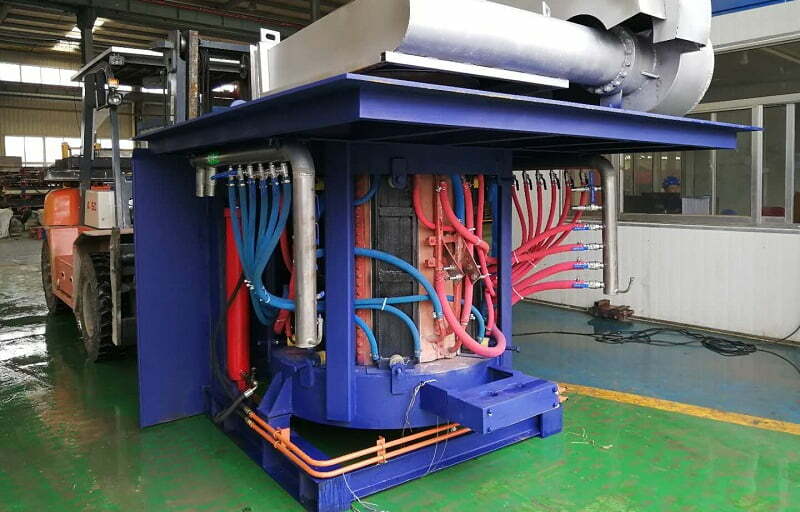Compared to electric arc furnace and induction furnace, induction furnace has the following characteristics in terms of refining capacity and adaptability.
A. Features in Terms of Refining Capacity
Electric arc furnaces are stronger than induction furnaces in terms of phosphorus, sulfur, and deoxidation capacity. The induction furnace is a cold slag, and the temperature of the slag is maintained by the heat provided by the molten steel. The electric arc furnace is a hot slag, and the slag is heated by an electric arc. The dephosphorization and desulfurization tasks can be completed through the slag, and the diffusion deoxidation can be fully performed through the slag. Therefore, the removal of phosphorus, sulfur and deoxidation ability of electric arc furnaces is better than that of induction furnaces.
The nitrogen content in steel smelted by an electric arc furnace is higher than that of an induction furnace. This is because the nitrogen molecules in the air in the arc high-temperature zone are ionized into atoms and then absorbed by the molten steel. The nitrogen content of the alloy smelted in the induction furnace is lower than that of the electric arc furnace, and the oxygen content is higher than that of the electric arc furnace. The rapid life value of the alloy is higher than that of the electric arc furnace.
B. High Yield Rate of Alloy Smelting Elements
The yield rate of alloy elements smelted by an induction furnace is higher than that of an electric arc furnace. The volatilization and oxidation loss of elements are large under the high temperature of the arc. The burning loss rate of alloying elements in induction furnaces is lower than that in an electric arc furnace. In particular, the burning loss rate of alloying elements in the returned material loaded with the furnace is much higher than that of the induction furnace.
During induction furnace smelting, the alloying elements in the returned material can be effectively recovered. During electric arc furnace smelting, the alloy elements in the returned material are first oxidized into the slag, and then reduced back to the molten steel from the slag, and the burning loss rate is obviously increased.
When the return material is smelted, the yield of alloying elements in the induction furnace is significantly higher than that in the electric arc furnace. For example, the yield rate of aluminum is 92%-96% for induction furnaces, 85%-90% for electric arc furnaces, 90%-94% for induction furnaces, and 85%-90% for electric arc furnaces. Alloying elements volatilize and lose a lot at the high temperature of the arc, and the induction furnace melts the alloying elements through induction heating with less loss.
C. Low Amount of Carburization of Molten Steel in the Smelting Process
The induction furnace relies on the principle of induction heating to melt the metal charge without the carburization of molten steel. Electric arc furnaces rely on graphite electrodes to heat the charge through an electric arc. After melting, the molten steel will be carburized. Under normal conditions, when smelting high-alloy alloy steel, the minimum carbon content in electric arc furnace smelting is 0.06%, and it can reach 0.020% in induction furnace smelting. The amount of carbon added in the electric arc furnace smelting process is 0.020%, and that of the induction furnace is 0.010%.
Non-vacuum intermediate frequency induction furnace is suitable for smelting low-carbon high-alloy steel and alloys.
D. Electromagnetic Stirring of Molten Steel Improves the Thermodynamic and Dynamic Conditions of the Steelmaking Process.
The movement conditions of the molten steel in the induction furnace are better than those of the electric arc furnace. Electric arc furnaces must install low-frequency electromagnetic stirrers for this reason, and its effect is still not as good as induction furnaces.
The electromagnetic stirring effect in the induction furnace improves the reaction kinetics and promotes the homogenization of the temperature and composition of the molten steel, but excessive stirring will not be conducive to the removal of inclusions and damage to the lining.
E. The Technological Parameters of the Smelting Process are Easy to Control.
The temperature control, refining time, stirring intensity, and constant temperature during induction furnace smelting are more convenient than electric arc furnaces and can be carried out at any time. The above-mentioned characteristics of the induction furnace play an important role in the smelting of high-alloy steel and alloys. It can produce products independently, and can also form a double-linked process with secondary refining such as electro-slag remelting and vacuum self-consumption.
Therefore, non-vacuum intermediate frequency induction furnace smelting has become an important smelting method for the production of high-speed steel, heat-resistant steel, stainless steel, electrothermal alloys, precision alloys, high-temperature alloys, and other special steels and alloys, and has been widely used

